With 31 points out of the opening 18 games, Wolfsberger AC sit in comfortable fourth position in the Austrian Bundesliga. They were in the exact same position last season at this stage of the year and so they continue to prove that they are among the best teams in country. In the UEFA Europa League they just got five points out of their six games against Borussia Mönchengladbach, AS Roma and Basaksehir, but in truth showed better performances than the results tell.
However, one of the breakout stars of this season is clearly the 20-years-old Anderson Niangbo. He played in 17 out of the 18 games in the Austrian Bundesliga and scored seven goals as well as assisted five. These are quite good stats for a 20-years-old who plays his first season in the highest league in Austria. He joined FC Liefering (RB Salzburg’s second team) in the January of 2018 and made 33 appearances for them in the second league of Austria since then. This season, he’s on loan at Wolfsberger AC and has tallied some outstanding performances.
In this tactical analysis in the form of a scout report, we’ll look at Niangbo’s movement on the pitch and his goalscoring ability as well as what differentiates him from a classic striker.
Positioning and movement
Gerhard Struber took over Wofsberg at the start of this season and introduced the 4-3-1-2 formation with Niangbo and Shon Weissman as the two strikers and the creative Michael Liendl behind them. Niangbo and Weissmann combined scored incredible 24 goals in the opening 18 games of this season.
The only attacking duo which has a better value in the Austrian Bundesliga is the one of RB Salzburg which was made of Patson Daka and Erling Braut Haaland. In the picture below we can see that Wolfsberg continue to use the 4-3-1-2 system even after Struber’s move to Barnsley.
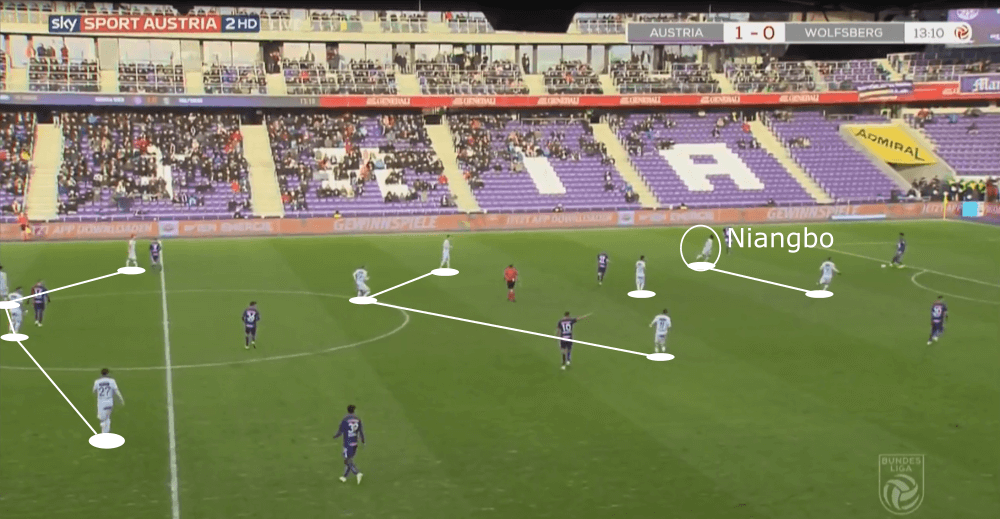
We can see that the three midfielders behind Liendl are positioned quite narrow when the opposition is in possession during the build-up. Even though they try to be positioned a bit wider when Wolsfberg is in possession of the ball, there is still nobody who occupies the wide areas in the higher lines as the full-backs can’t rush permanently forward due to their defensive duties.
At this point, Niangbo comes into play as he is a very agile and fast player as you expect a winger to be. As Weissmann has more physical strength and is taller, the Israeli stays more centrally while we can often see Niangbo drifting to the left side. This also gets visible when we look at his heatmap for the games in the Austrian Bundesliga and the UEFA Europa League of this season.

While Weissmann is mainly positioned in the centre and on the height of the last defensive line of the opposition, Niangbo often moves to the left-wing or drops deeper to get involved in the game as we’ll see later in this analysis. These tactics perfectly fit the two forwards as Weissmann is more of an out and out attacker while Niangbo likes to get involved in the build-up or positions wider to receive through passes on the wing.
In such a situation, he can make use of his incredible acceleration and pace – two physical qualities which help him in several situations as we’ll see in the other parts of this tactical analysis. The shot below shows us a situation in which the 20-years-old Ivorian is positioned on the left wing to receive a good through pass.
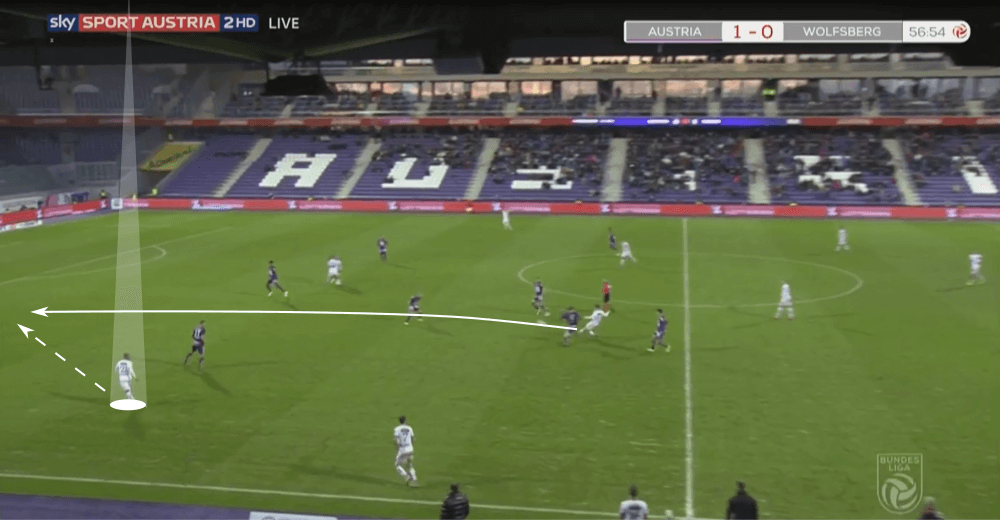
Working for the team
However, before we look at Niangbo’s actual style of play when he is on the ball and his team is in possession of the ball – which are usually the most interesting situations when we look at a striker – we will now see that the Ivorian is also an important part of Wolfsberg’s defensive tactics. His 2.19 recoveries and 1.55 interceptions per game are not any outstanding numbers for an offensive player.
At first glance, it shows that he wins back balls for his team, but not significantly often. However, another value indicates better what his real part in Wolsfberg’s tactics is as 73.2% of his recoveries are made in the half of the opposition’s team. And here we see the problem with stats on such occasions since Niangbo is a forward who permanently executes a high pressing together with his partner Weissmann and they often force their opponents to uncontrolled long balls which can easily be defended by the defenders.
In the image below, we can see such an example as Niangbo uses a curved run to cut off the passing option for Austria Vienna’s goalkeeper. Additionally, Weissmann is positioned high to be near the other two other short passing options. This forces the keeper to a long ball which results in possession for Wolfsberg and Niangbo as well as Weissmann are the two who are responsible for that long ball. Such situations, howevr, can’t be shown in statistics.
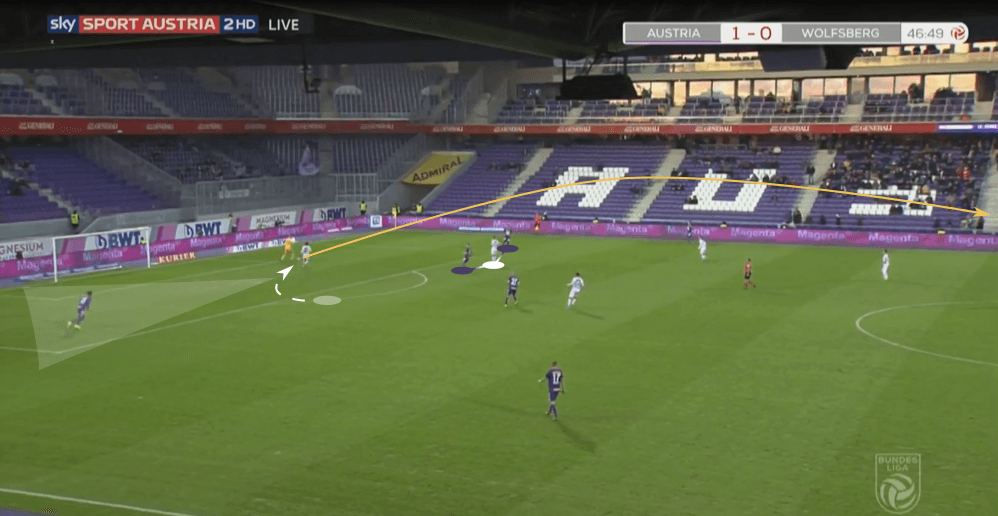
The following image shows us quite a similar situation in their UEFA Europa League fixture against AS Roma. Weissmann forced the goalkeeper to play the ball to Alessandro Florenzi. Additionally, Liendl marked the central passing option, isolated Florenzi and gave Niangbo the chance to put pressure on him as he just had the vertical passing option.
The Italian wanted to play a vertical pass, but Ninagbo expected this as it was the only option and intercepted it. However, he was not able to control the ball and just blocked it as it went back to Florenzi who had then no other chance than to play an uncontrolled long ball. These two examples show that Weissmann and Niangbo do a great job in putting pressure on opponents high up the pitch.
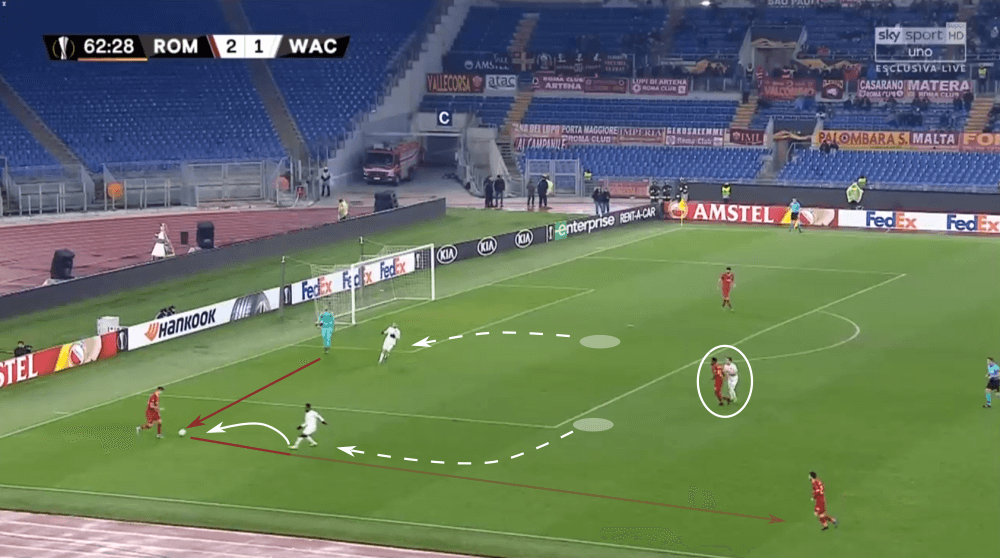
However, the Ivorian doesn’t only press high up the pitch to disrupt the opposition build-up but also to support his teammates in the half of Wolfsberg.
Niangbo knows that he has to help in defence as this is important for his team. The example below shows that as he sprints back to be near the opponent who shoots. Since Niangbo is close to him, the shot is uncontrolled and goes wide.
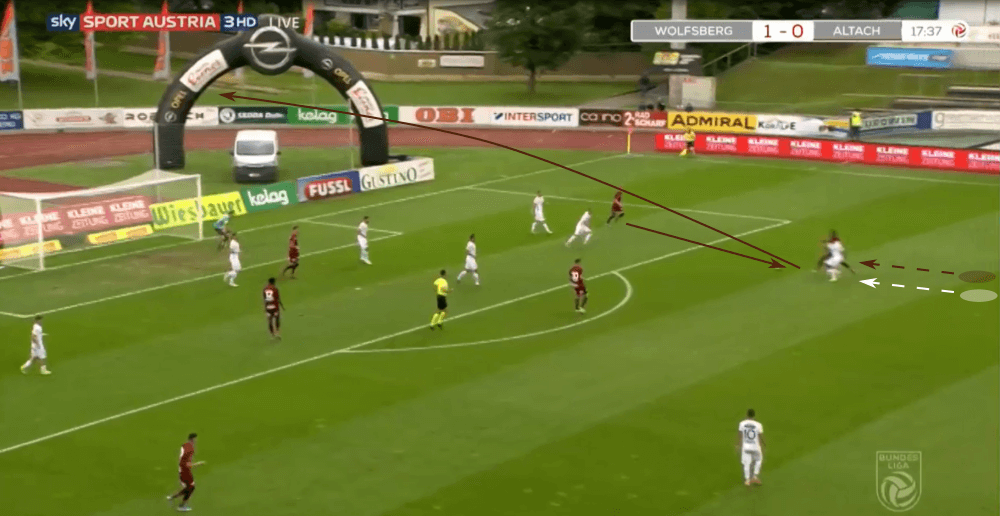
Getting involved
So, in the light of his defensive contribution, it seems as Niangbo is a modern striker as he is also ready to do defensive work when necessary and when his team needs him. You have to give him much credit for that as nowadays strikers often just get measured by their goalscoring record and forwards who work hard for their team don’t get the recognition that they deserve.
As already mentioned earlier in this analysis, the 20-years-old rarely stays in the central area upfront next to Weissmann but likes to drop deeper or position himself in the wide-areas to provide width. When he is positioned on the wing, he can perfectly utilise his pace to either receive through passes or beat the opponent in a one-on-one situation.
However, he often shows intelligent movements and positions himself in a deeper line to receive the ball without having a centre-back directly behind him. He then can turn around and exploit the space around him. In the image below we can see such a typical positioning by the Ivorian.
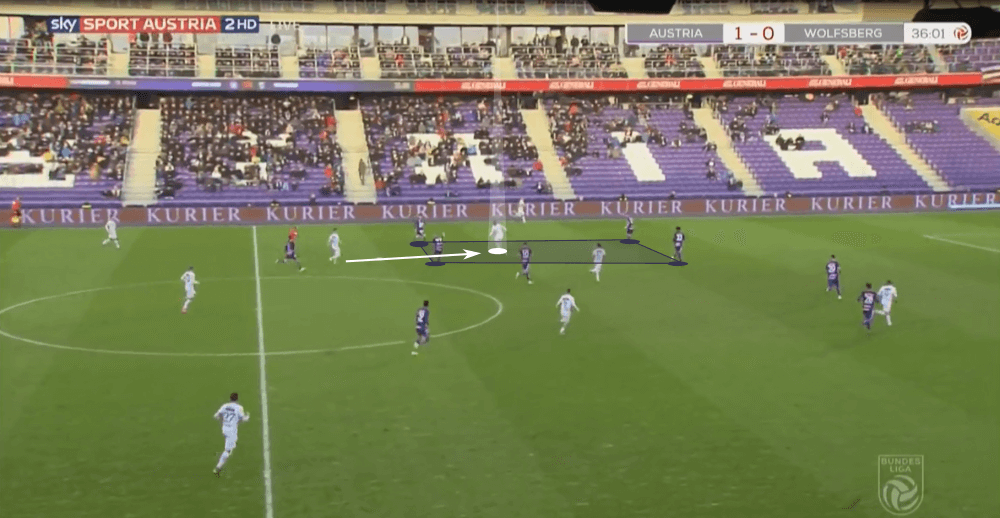
The fact that he plays 25.1 passes per game and makes 4.33 dribbles per 90 minutes shows that Niangbo isn’t an out and out striker, but likes to get involved in the attacks of his team and not just be the last player to touch the ball in front of the goal to score. Instead, he likes to have a give and go with a teammate or dribble past one or two defenders.
And such actions mainly work in deeper areas as there he has more freedom compared to the highest line. This also explains why he likes to drop deeper. The shot below shows us a typical situation as he received the ball in a deeper position to exploit the free space with a dribble and then play a good and logical pass to his teammate.
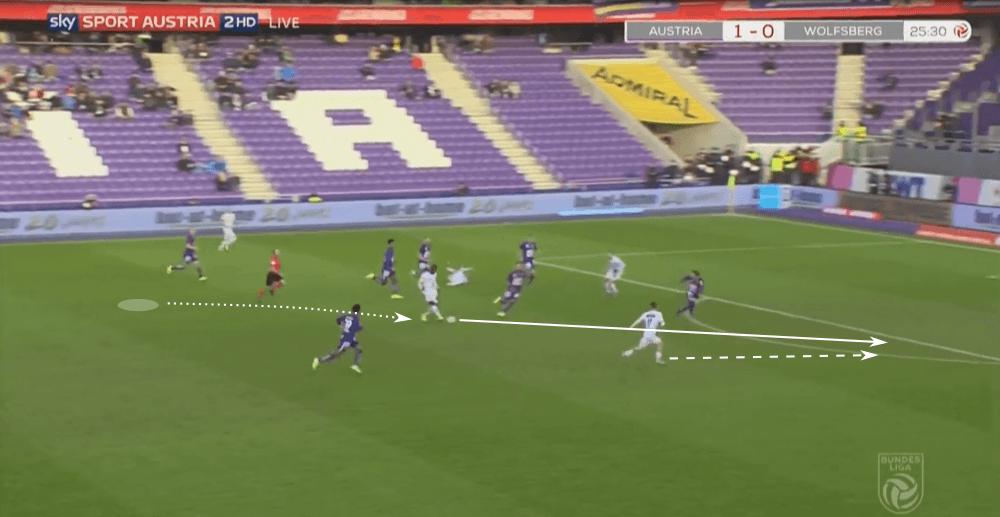
However, it would be a big surprise if Niangbo was such a complete and modern striker who scores and assists on a regular base and also works defensive hard for his team as well as likes to get involved in the build-up, all at the age of 20. That he seems to be sloppy on numerous occasions is completely normal for a player of his age, but another thing that becomes visible is that he often misses the ideal moment when to pass the ball.
48.1% of his dribbles are successful onn average, but the main reason why it is not higher is that he often stays too long on the ball. In the example below, he has three passing options but instead continues his dribble against three men and loses the ball.
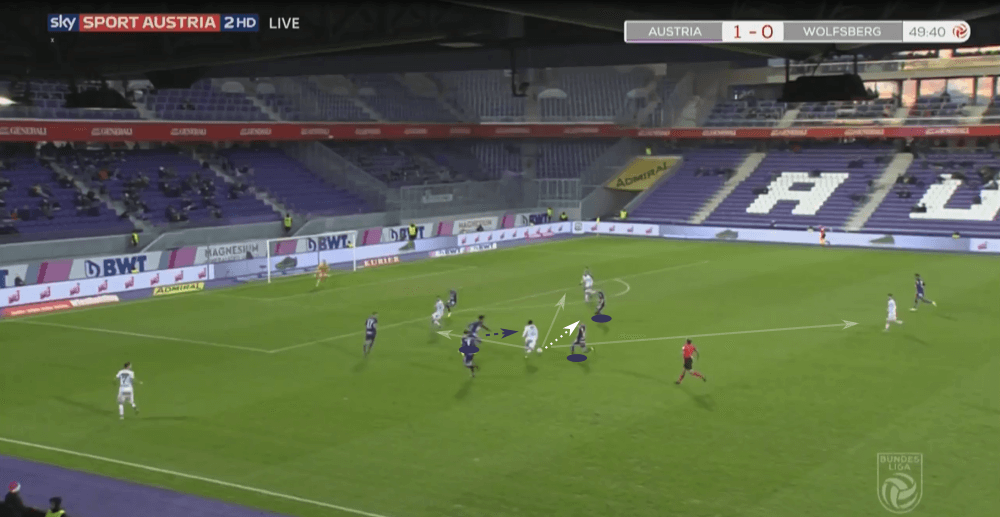
Dangerous in front of the goal
Lastly, we will now look at the two aspects of the game which are still the most important ones for strikers: assisting and scoring goals. The already described tactics that Niangbo isn’t permanently in the central zone upfront is also one of the reasons why he scored seven goals while Weissmann scored 17 times in the Austrian Bundesliga in this season. On the other side, the Israeli provided just two assists while Niangbo has five.
Since the Ivorian is often the one who is positioned deeper or in the wide areas (like in the example below) he is often the one who creates goalscoring chances while Weissmann is the one who then scores. In the images below we can see that the 20-years-old Ivorian is in the left wide area on the ball and creates a two-on-one situation with Lukas Schmitz (#7) to then deliver a low cross which Weissmann converts into a goal.
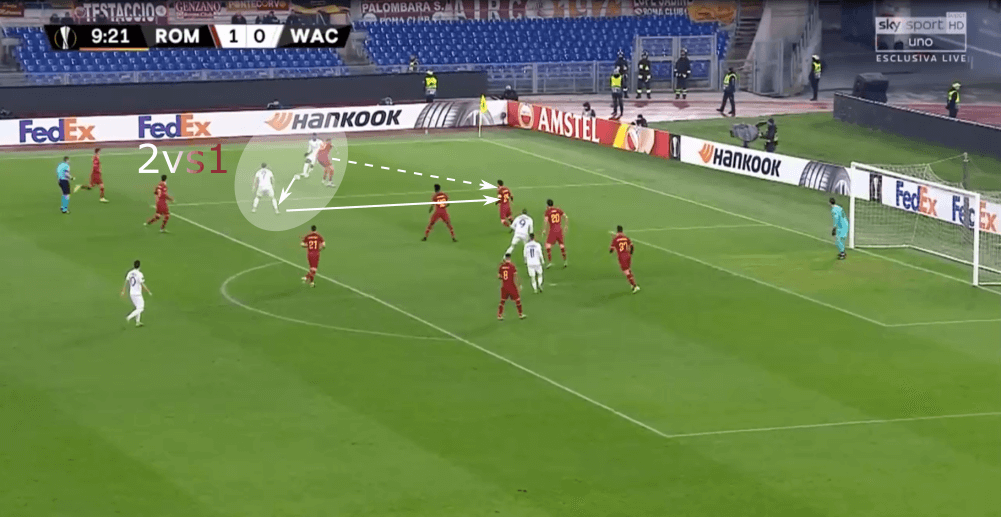
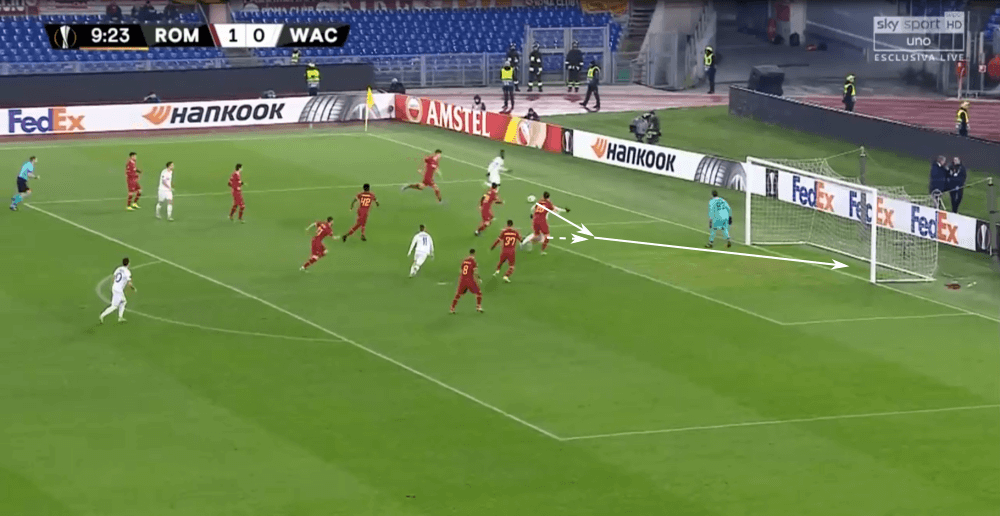
However, Niangbo doesn’t just use his speed and acceleration to get into the last line of the opposing defence on the wing or to dribble past defenders, but also to receive vertical passes through the centre. Such passes are incredibly hard to defend against for the opposing defenders due to Niangbo’s speed.
The image below shows us such a situation as the Ivorian receives a through pass, uses his speed to dribble with the first touch past the goalkeeper and then scores.
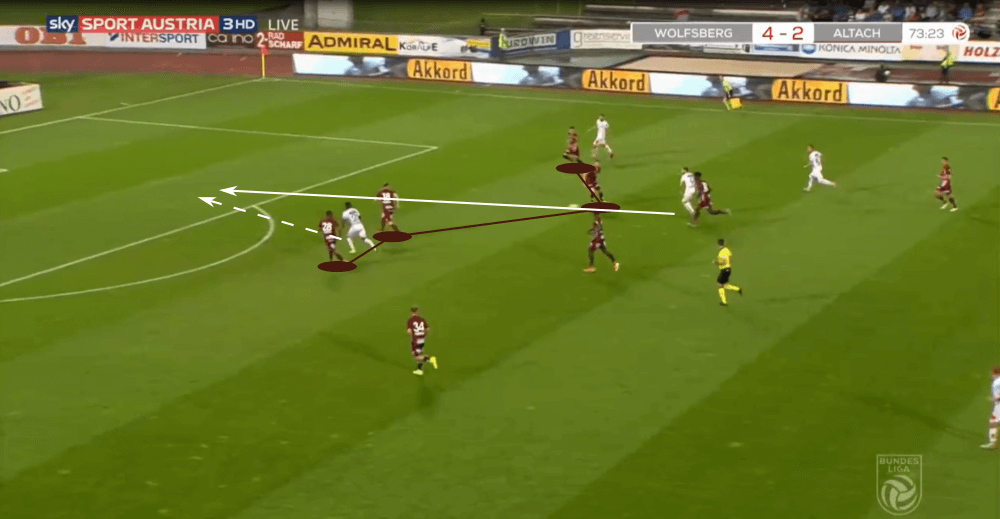
Even though the 20-years-old isn’t the tallest player, he also likes to join Weissmann in the penalty box to receive crosses from his teammates instead of delivering them. So, we once more see that Niangbo is quite a versatile player on the football pitch.
When he is in the box to convert a cross into a goal, he must always look for free space to position himself in so he can win the aerial duels against the defenders due to his size (he only wins 14.5% of his aerial duels). Such intelligent positioning ahead of the goal can be seen in the image below.
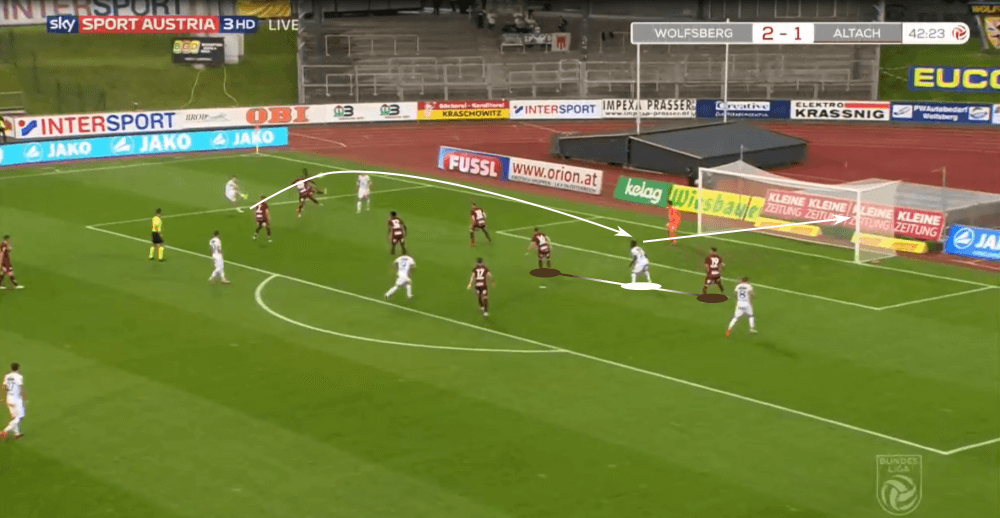
Conclusion
As this scout report showed, Niangbo’s greatest strength is probably his versatility: He works hard for his team when it comes to winning back the ball, drops deeper to get involved in the build-up, positions in the wide areas to utilise his pace and deliver crosses, and likes to get in front of the goal to score. As you can expect all of this from the young Ivorian, it’s really hard for the opposition to defend against him.
It will be interesting to watch how he and Wolfsberg perform in the remaining games of the season and what will happen with him in the summer when his loan ends. He may be moved to the first team of Salzburg and become a regular part of their squad. The remaining months of this season will show what comes next for him.

If you love tactical analysis, then you’ll love the digital magazines from totalfootballanalysis.com – a guaranteed 100+ pages of pure tactical analysis covering topics from the Premier League, Serie A, La Liga, Bundesliga and many, many more. Buy your copy of the December issue for just ₤4.99 here





Comments